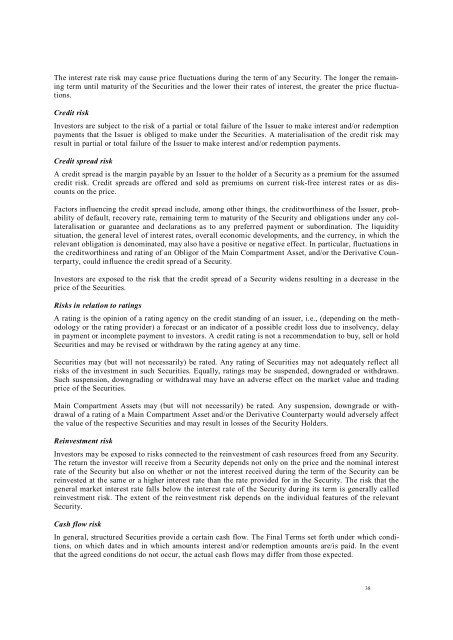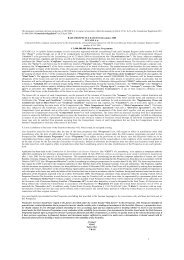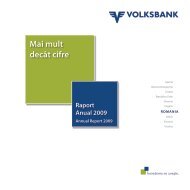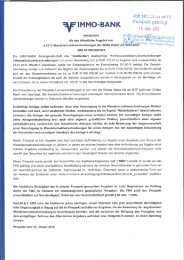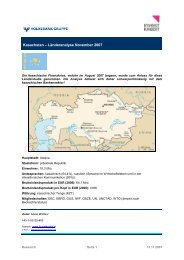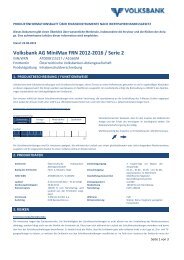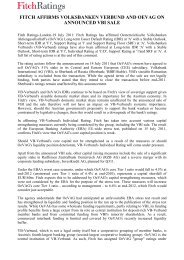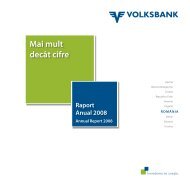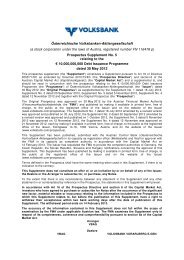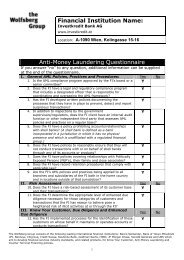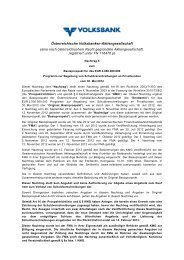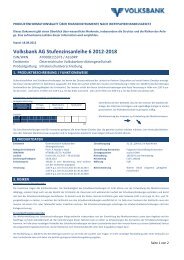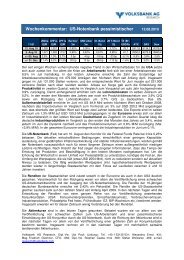EUR 3000000000 debt issuance programme, 10 ... - Volksbank AG
EUR 3000000000 debt issuance programme, 10 ... - Volksbank AG
EUR 3000000000 debt issuance programme, 10 ... - Volksbank AG
You also want an ePaper? Increase the reach of your titles
YUMPU automatically turns print PDFs into web optimized ePapers that Google loves.
The interest rate risk may cause price fluctuations during the term of any Security. The longer the remaining<br />
term until maturity of the Securities and the lower their rates of interest, the greater the price fluctuations.<br />
Credit risk<br />
Investors are subject to the risk of a partial or total failure of the Issuer to make interest and/or redemption<br />
payments that the Issuer is obliged to make under the Securities. A materialisation of the credit risk may<br />
result in partial or total failure of the Issuer to make interest and/or redemption payments.<br />
Credit spread risk<br />
A credit spread is the margin payable by an Issuer to the holder of a Security as a premium for the assumed<br />
credit risk. Credit spreads are offered and sold as premiums on current risk-free interest rates or as discounts<br />
on the price.<br />
Factors influencing the credit spread include, among other things, the creditworthiness of the Issuer, probability<br />
of default, recovery rate, remaining term to maturity of the Security and obligations under any collateralisation<br />
or guarantee and declarations as to any preferred payment or subordination. The liquidity<br />
situation, the general level of interest rates, overall economic developments, and the currency, in which the<br />
relevant obligation is denominated, may also have a positive or negative effect. In particular, fluctuations in<br />
the creditworthiness and rating of an Obligor of the Main Compartment Asset, and/or the Derivative Counterparty,<br />
could influence the credit spread of a Security.<br />
Investors are exposed to the risk that the credit spread of a Security widens resulting in a decrease in the<br />
price of the Securities.<br />
Risks in relation to ratings<br />
A rating is the opinion of a rating agency on the credit standing of an issuer, i.e., (depending on the methodology<br />
or the rating provider) a forecast or an indicator of a possible credit loss due to insolvency, delay<br />
in payment or incomplete payment to investors. A credit rating is not a recommendation to buy, sell or hold<br />
Securities and may be revised or withdrawn by the rating agency at any time.<br />
Securities may (but will not necessarily) be rated. Any rating of Securities may not adequately reflect all<br />
risks of the investment in such Securities. Equally, ratings may be suspended, downgraded or withdrawn.<br />
Such suspension, downgrading or withdrawal may have an adverse effect on the market value and trading<br />
price of the Securities.<br />
Main Compartment Assets may (but will not necessarily) be rated. Any suspension, downgrade or withdrawal<br />
of a rating of a Main Compartment Asset and/or the Derivative Counterparty would adversely affect<br />
the value of the respective Securities and may result in losses of the Security Holders.<br />
Reinvestment risk<br />
Investors may be exposed to risks connected to the reinvestment of cash resources freed from any Security.<br />
The return the investor will receive from a Security depends not only on the price and the nominal interest<br />
rate of the Security but also on whether or not the interest received during the term of the Security can be<br />
reinvested at the same or a higher interest rate than the rate provided for in the Security. The risk that the<br />
general market interest rate falls below the interest rate of the Security during its term is generally called<br />
reinvestment risk. The extent of the reinvestment risk depends on the individual features of the relevant<br />
Security.<br />
Cash flow risk<br />
In general, structured Securities provide a certain cash flow. The Final Terms set forth under which conditions,<br />
on which dates and in which amounts interest and/or redemption amounts are/is paid. In the event<br />
that the agreed conditions do not occur, the actual cash flows may differ from those expected.<br />
38


